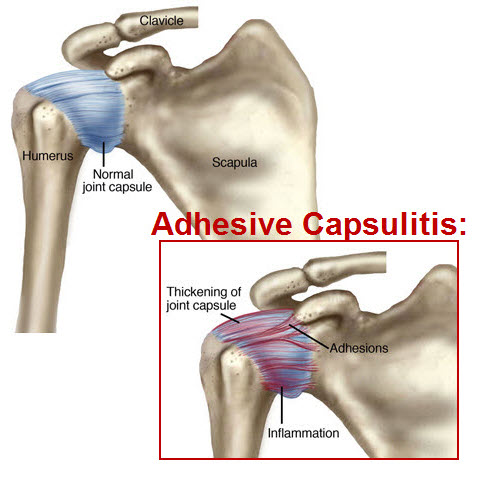Frozen shoulder, also known as adhesive capsulitis, is a common cause of shoulder pain.
In the frozen shoulder, the capsule which surrounds the shoulder joint is impacted. This capsule is a deep layer of fibrous tissue which stretches and tightens to protect the joint while you move your arms.
Implications of Having a Frozen Shoulder
At the start of the frozen shoulder, the joint becomes inflamed and scar tissue will form. As it progresses the capsule will continue to thicken and shrink resulting in decreased shoulder range of motion. With the changes in the capsule, there will be increased nerve growth which contributes to the pain felt within the shoulder.
Additionally, the inflammation and changes within the joint can influence the rotator cuff causing thickness and fibrosis to form here as well and this will cause further decreases in mobility. The loss of mobility will progress over the course of the condition to a point where the shoulder is completely frozen which results in a loss of the normal movement patterns used in your daily life.
Some activities that you may find difficult with frozen shoulder are:
- Throwing
- Reaching behind your back to tucking in a shirt or put on a belt
- Driving
- Putting on a seatbelt
- Sleeping on your side
- Putting away dishes
- Brushing your hair
- Putting a shirt on
These activities typically require an adequate range of motion and the ability to bring arms above shoulder height. Therefore, a frozen shoulder can greatly impact your quality of life and participation in activities of daily living.
Although this usually only impacts one side, it can also spread to the other side. This condition can occur at any age, but typically occurs between the ages of 40 to 65 years old and is usually more common in women.
Classifications of Frozen Shoulder
In this condition, there are two main classifications based on the potential causes.
- Primary frozen shoulders are considered idiopathic, which means there is no known cause.
- In secondary frozen shoulder, it is related to other conditions or risk factors that increase the likelihood of developing adhesive capsulitis.
These risk factors can be divided into intrinsic, extrinsic, and systemic categories.
- Intrinsic risk factors are related to pathology within the shoulder itself. Some examples are rotator cuff tendinopathy, shoulder surgery, posture, local trauma, or decreased use of the shoulder because of the previously mentioned risk factors.
- Extrinsic risk factors are related to pathology that occurs near the shoulder. Some examples are fractures of the arm or collarbone, muscle imbalances, sporting movements, frozen shoulder in the opposite arm, stroke, or neck dysfunction.
- Lastly, there are systemic causes such as diabetes, heart disease, menopause, or high blood pressure which may increase the risk.
Four Stages of Frozen Shoulder
- Stage 1, also known as the pre-freezing stage typically occurs between 0 to 3 months and is characterized by increased pain and aching in the shoulder and some stiffness influencing range of motion.
- This then transitions into stage 2, also known as the freezing stage, which typically occurs between 3 to 9 months. As this stage progresses there are continuous decreases in shoulder mobility and movements become extremely painful.
- In stage 3, also known as the frozen stage, the pain gradually reduces while stiffness increases. This stage typically occurs between 9 to 15 months and is characterized by severe stiffness which greatly impacts function.
- Stage 4 is known as the thawing stage. This typically occurs between 15 to 24 months and is characterized by minimal pain and slow increases in shoulder range of motion.
The onset of frozen shoulder can be confused with a variety of other shoulder conditions such as rotator cuff injury, arthritis, and bursitis. Physiotherapy can be an important resource to help confirm if the frozen shoulder is the cause of your shoulder pain.
Additionally, physiotherapists are trained in providing appropriate treatment for primary and secondary frozen shoulder and can appropriately modify the treatment based on the stage you are in.
What to Expect During Your Appointment for a Frozen Shoulder Physiotherapy in North Vancouver?
During the appointment, our Cypress physiotherapists in North Vancouver will provide an assessment that is individually tailored to your shoulder pain. This will include gathering a detailed history from you and spending some time to identify any underlying intrinsic, extrinsic, and systemic risk factors that may be related to your frozen shoulder.
From there, we will perform a detailed assessment of your shoulder which includes looking at your range of motion, the muscles surrounding, and completing special tests to rule out other conditions. We may also look at your neck and other surrounding areas to find many contributing factors.
From there, our physiotherapists in North Vancouver will develop a rehabilitation plan tailored to your specific individual needs and the stage of your frozen shoulder. To treat your frozen shoulder, we may use physiotherapy treatment techniques such as manual therapy, Intramuscular stimulation (IMS), exercises therapy, pain management, and shoulder mobilizations.
Additionally, we will provide education to help inform you which stage of the frozen shoulder you are on and what the goals of treatment are in this stage.
The physiotherapy techniques will be modified for each stage:
- In pre-freezing and freezing our management will be tailored to provide low-intensity treatments and range of motion exercises that are focused on pain management.
- In the frozen stage the intensity of the manual therapy treatments will be increased, and exercises will be modified to focus on flexibility, strength, and mobility with the goals of managing stiffness and pain.
- In the thawing stage, the treatments and exercises will be progressed to target the stiffness and help you regain your strength and shoulder range of motion in order to get back to participating in activities of daily living.
With a frozen shoulder, you will typically have to move through the 4 stages. The timeframe can vary but typically takes between 12 to 24 months.
By understanding the biomechanical and orthopedic underpinnings of how the body works, we can selectively employ the right techniques and create a sustainable and effective care plan to support you as you progress through the stages of frozen shoulder and help you get back to full, pain-free functioning and participating in the things and activities that you love.
Call or go online to book an appointment for your frozen shoulder with Cypress Physiotherapy and Health in North Vancouver.



